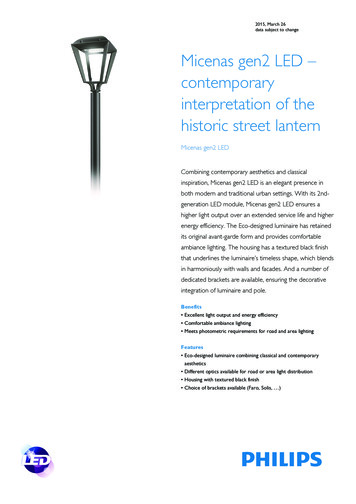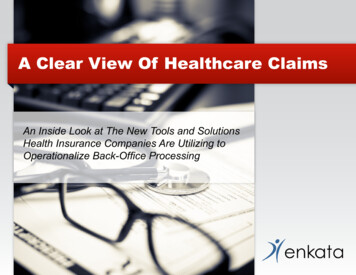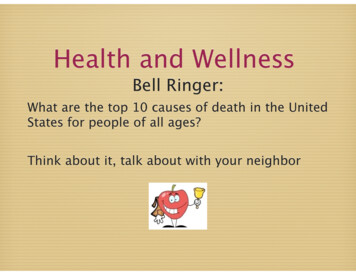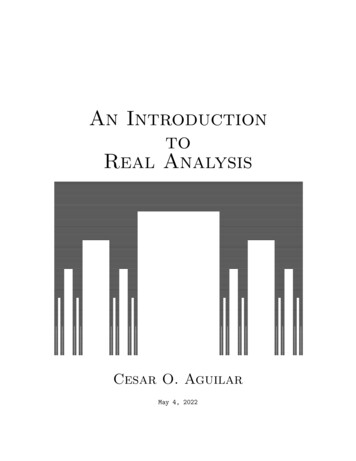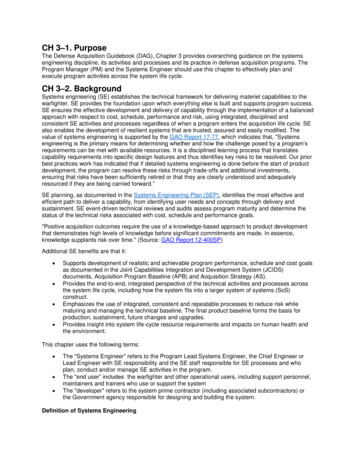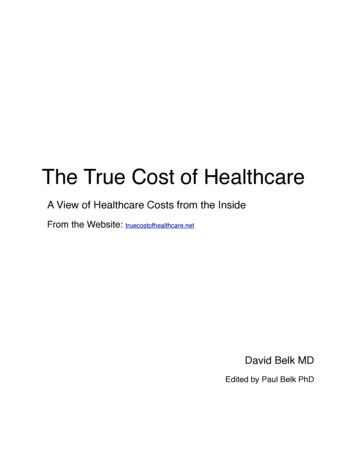
Transcription
The True Cost of HealthcareA View of Healthcare Costs from the InsideFrom the Website: truecostofhealthcare.netDavid Belk MDEdited by Paul Belk PhD
Table of Contents with Summary Points1) Hidden CostsPage 5a. Almost all health care costs are hidden from both doctors and patients.b. Any cost that’s hidden or confusing is easy to inflate.2) Medications: What Your Pharmacist Won’t Tell YouPage 7a. Most generic medications aren’t 50% or 75% less expensive that their brand namedequivalents, they are 100 times cheaper!!b. Most people can pay less for medications if they pay for them directly than if they use theirinsurance and pay a copay (people pay extra for the privilege of being overcharged).c. The Costco list at the end is only partial but it’s obvious 32.95 a year is a lot less than 10 amonth.3) Medications: The Bad NewsPage 10a. When medications are expensive, they can be REALLY expensive!b. It doesn’t help that the patents on many of the most expensive medications have beenextended (artificially) for decades.c. The tips given at the end of the section would be useful to most peopled. Pharmaceutical reps should be banned.4) The Pharmaceutical IndustryPage 12a.We in the U.S. pay far more than anyone, anywhere else in the world for brand nameprescription medications.b.Pharmaceutical companies do spend a lot of money on research but they spend nearlytwice as much on marketing as they spend on research. They also make more in profits,on average, than they spend on research.c.Not all of the money they spend on research goes toward developing good products.d.The entire pharmaceutical industry appears to be living on borrowed time.2
5) Office BillingPage 28a. Most doctors have no idea how much they’re paid for what they do.b. We give insurance companies discounts to abuse us every day while private payers (theuninsured) are overcharged.6) Hospital BillingPage 35a. Hospital Bills are, for the most part, works of complete fiction.b. Inflating the charge on every service a hospital provides has two major consequences:i.It gives an unrealistic (inflated) impression of how much health care really costs.ii. It further allows hospitals and insurance companies to abuse people.7) Hospital Financial AnalysisPage 40A comprehensive study was done of the annual financial reports for 387 Californiahospitals over nine years. In doing it we discovered:a.i.Hospital census is declining year over yearii.Hospitals give very little free careiii.Hospitals get a little more than 1/4th of what they bill from all payersiv.In spite of low average reimbursement rates, many hospitals are still making hugeprofits8) Diagnostic TestsPage 54a. Most diagnostics tests and procedures are inexpensive to perform.b. The charges for these tests, however, have no relation to the actual cost (or expectedreimbursement) of these tests.c. 50 million people are denied access to basic healthcare in this Country, not because they can’tafford it, but because they’re not allowed to afford it.d. No one would use their auto insurance to fill their gas tank or change their oil. No one woulduse their home owner’s insurance to pay their electric bill so why do we use our healthinsurance to pay for a urine analysis or a blood count?3
9) Health Insurance: More Tricks of the tradePage 62a. Just because you have health insurance, it doesn’t mean you’re necessarily getting a gooddeal on your health care.b. Concrete examples are given which show how health insurance companies can manipulate apatient’s out of pocket payments to make it appear as though health care is more expensivethan it really is.c. Insurance companies sell security against financial risk. If no one really understands whatthat risk is (because all prices are hidden or deceptive) then the price of the security(insurance) can be grossly inflated.10) Medical Malpractice: Myths and RealitiesPage 66a. My medical malpractice premiums are a trivial amount and I posted my bill to prove it!b. The cost of medical malpractice has dropped dramatically in the last decade.11) Conclusion: How did we get here and why is this so hard to fix? Page 73a. How did we in the US end up with the most expensive and inefficient health care system inthe developed world?b. Where is all of the money going?c. Why is it so difficult to reform our health care system?4
INTRODUCTION: HIDDEN COSTMost people will tell you that health care in the US is expensive. We Americans spend moremoney per person on health care than anyone, anywhere else. But people don't agree on why ourhealth care is so expensive. Is it because of all the new technology we use in health care? Or, is itbecause too many lawyers are suing doctors? Do we over-utilize our resources? Do we have toomany government regulations or maybe too few? Is our health care “market” too free or not freeenough? Or, is it just because we have the beast health care in the world and that’s the price wepay for being so healthy?Contradictory though they are, each of these arguments seems to have passionate championswith copious amount of their own “evidence”. So, who’s right? About five years ago I decidedto see what I could do to find out.My approach to the problem was unusual. Most people studying health care are external expertswho look from the outside in. Since I'm a practicing physician, I could go from the inside out.Instead of trying to address any of the above arguments, I decided I would try to answer what Ithought was an obvious question that no one else appeared to be asking: What do all the productsof health care actually cost? How much does an x-ray really cost? a CT scan or an MRI? Are allprescription medications really expensive? How much do they really cost?Even though these might seem like obvious questions, very few people appear to know theanswers. Almost no one, including most doctors, has the slightest idea what much of what we doactually costs. So I started looking at the problem privately: myself, my patients, the otherphysicians in my area.Why don't we know these costs? To start with, unlike any other business in America, almost allof the financial transactions in healthcare are hidden from the providers as well as the patients.We doctors order tests, procedures and medications to manage our patients, but very few of ushave any idea how much any of those things cost. Patients rarely pay directly for these servicesand payment for any service varies substantially from different payers. Billing charges for amedical service typically have little relation to the actual cost of the service or even to theexpected reimbursement rate for that service.Hospitals have separate billing departments that are far removed from anyone ordering orperforming tests or procedures. No one directly involved with patient care has any notion of thecharge or reimbursement for their service. Most private doctor's offices don't even bill their ownpatients—they contract billing companies, who just send them a check each month from the totalamount collected, leaving them no notion of the actual charge or payment for an individualservice they provided.So for years we’ve been discussing the total cost of a system where almost all of the individualcosts of that system are completely hidden from us. Is it any wonder the cost of health care in theUS has mystified so many?5
My research started rather modestly. I collected bills my patients brought me from hospitals anddiagnostic labs and examined how much was charged for various medical services and whatinsurance companies actually paid for these services. I called pharmacies to ask how muchmedications cost my patients, and occasionally they would also tell me what the pharmaciesthemselves paid for them. I also called imaging centers and asked them how much they chargedfor different scans. To address the cost of litigation, I looked at malpractice premiums: mine andthose of several of my colleagues.As limited as my initial research was, it provided a lot of information I couldn’t obtain fromother sources. But in the years since, the scope of my research has broadened considerably. I’veborrowed the computer skills of my brother (a medical scientist and software analyst) to examineand analyze years of financial records from hundreds of hospitals, as well as those of most majorpharmacies, insurance companies and pharmaceutical companies. I’ve acquired weekly listsshowing the average all pharmacies pay for every medication they buy, state by state statistics onmedical malpractice costs going back more than a decade and much more.The goal of this website is to provide the results of all of my research as well as to untangle andexplain as much about the US health care system as I can. The website itself contains multipledifferent sections that deal with the cost of different aspects of healthcare: medications, officevisits, hospitalizations, tests, procedures and insurance. There are also sections that provide anextensive financial analysis of some of the industries in health care and several reference sectionsthat provide hundreds of links to all of the sources and data I use.I promise that each section on each type of medical cost will have a lot of information that seemsbizarre. It seems bizarre because it is. When people talk about the "US healthcare system," theyoften like to point to it being a "free market system." What's bizarre is that nothing I'm going todescribe looks very much like a market at all; either free or regulated. As I said, no one appearsto know what anything costs--not the people buying (the patient), not the people selling (thedoctors and hospitals). The cost of a product is a central feature to any market system. If no oneknows what these costs are, how can this "market" be "free"?6
MEDICATIONS: WHAT YOUR PHARMACIST WON'T TELLYOUIf there's any cost that should be easy to understand, it's the cost of prescription medications. Pharmaciesbuy prescription drugs in bulk from pharmaceutical suppliers the same way they buy aspirin, and then sellthem for a profit. But somehow this simple transaction is wrapped in so many layers of confusion thatalmost no one understands what's really happening. So let's start by trying to figure this out.Anytime you go to a store (say, a grocery store) you expect to see all of the products being sold with theirprices plainly displayed. When you go to the checkout, that's the price you expect to be charged. You alsoexpect to be able to check the price of the same or a comparable product in competing stores so you canshop around. That's how the free market works.Imagine what it would be like if a grocery store never displayed the price of anything. And the priceyou're charged might be totally different from the price the next customer is charged for the same product.In fact, suppose you couldn't even pick your own groceries. A grocery list would be handed to you by afood expert and you’d be billed based on your particular “grocery plan”. Eggs might cost you 5, the nextperson 10 and some poor guy who doesn’t have a grocery plan would have to pay 50 for the samecarton. Don't even think about shopping around. Your grocery plan follows you everywhere anddetermines the price you pay and, since you’re only allowed to buy what’s on the list, you can’t evenprice compare similar items (like brown eggs vs. white eggs). The only way to save money would be togo without groceries. Do you think this would make food cheaper or easier to get? Well, what’s describedabove is pretty close to how prescription medications are sold in the U.S. Why?IN THE BEGINNINGMost of the useful medications doctors now prescribe were developed prior to 1995. Prior to 2000 thevast majority of these medications were brand name only and rather expensive. A typical medication forhigh blood pressure or high cholesterol would cost 4- 5 per pill. For medicines taken daily (or worse 2-3times per day) this could add up very quickly. This is especially true for a person taking 5 or 6medications daily for a number of chronic diseases. Drugs started to become a significant portion ofpeople's medical costs, so insurance companies stepped in and offered plans that would cover a number ofthese medications (with many restrictions). Under these plans, the patient might only be responsible for a 10- 20 monthly copay instead of the regular 100- 150 monthly cost per medication.TIMES HAVE CHANGED.In the last decade most of the patents for these medications have expired, so now more than 80% of themedicines that are commonly prescribed by doctors are generic and very cheap. Medications that used tocost pharmacies 400 for 100 pills (and then were sold to you for a profit) now cost pharmacies anywherefrom 1- 10 per 100 pills. That's right: many medications got more than 100 times cheaper. What theysell them for, though, is their business.Most pharmacies realized that it wasn’t in their best interest to tell anyone that drug prices were dropping.With everyone used to using insurance to buy their medication, the pharmacies could just continue tocharge the same copay, and make a substantial profit without receiving any payment from the insurance7
company. In the meantime, the insurance companies were happy because people still bought prescriptiondrug coverage for these medications, believing that they were saving money when, in fact, they weren't. Itcost the insurance company nothing, so everyone won (except the customer).The copays are still based entirely on the insurance plan so the same medicine in the same pharmacymight cost 5, 10 or 25 for a month’s supply. To see how much of a windfall this is for retailpharmacies, we need only to look at the finances of the two largest retail pharmacies in the US; CVS andWalgreens. Since 2001 both CVS and Walgreens have tripled their total revenue from retail pharmacysales and doubled their number of retail pharmacies in the US. They were able to fund this growth mostlyfrom the sale of generic prescription medications sold to customers, almost all of whom used a third partypayer (insurance) to buy their prescriptions.What’s more, people might pay several hundred dollars a year to get prescription drug coverage on theirinsurance, even though that coverage increases the cost of many medications and cost the insurancecompany nothing. It's like buying a book of coupons that say "one for the price of two" at your localgrocery store. You can see why they didn't want to tell you about it.SOMEBODY HAD TO FIGURE IT OUT, RIGHT?For years now, Wal-Mart has been very open about their policy of selling generic prescriptionmedications to people without insurance. For 4, an uninsured person could get a one month supply of ageneric medication. 10 bought 3 months of the same medication. Many have accused Wal-Mart of usingtheir size and purchasing power to undercut the competition. In reality, Wal-Mart has nowhere near thevolume of prescription medication sales Walgreens or CVS has. Smaller retail pharmacies like those inWal-Mart or Target can easily sell generic prescription medications at those prices and still make a profitbecause these medications are inexpensive to all pharmacies. The real story was that few otherpharmacies were doing what Wal-Mart was doing. .Costco does the same thing in a slightly different way. They buy medications from pharmaceuticalsuppliers and then sell them for slightly more than what they pay. In other words, Costco buys and sellsprescription medications in the same way they buy and sell everything else in their stores. And this issomehow revolutionary? That alone should tell you how absurd the medical field is, and why prices are sohard to control. (Note: I'm not just giving Costco free advertising. I mention them because, so far, they'vegiven the closest thing to the actual price of these medications and that's what I'm trying to find).To show just how inexpensive most generic medications really are, I created a list showing the prices ofseveral hundred commonly prescribed generic medications (see medication table). I give both the averageprice all retail pharmacies in the US paid for each medication in September 2015 as well as Costco’s pricefor each medication that month. When reviewing the prices on this table, consider what your copay wouldbe for those medications then add to that copay the cost of your prescription drug coverage.As examples, here are six receipts (next page) a patient of mine recently brought me from Costco. As youcan see, the receipt is dated 3/17/2016 and this patient bought a full year’s supply of five differentmedications: Metformin for diabetes; amlodipine, atenolol and hydrochlorothiazide and lisinopril for highblood pressure and simvastatin for high cholesterol. What was the total for all six medications? 151.82for the whole year! Most people spend more than than for groceries each month.8
9
MEDICATIONS: THE BAD NEWSThe cost of medications isn't always inflated at the pharmacy. Even though more than eighty percent ofprescriptions written in the US are for generic medications, there are still many diseases for which noinexpensive treatments exist. If a pharmaceutical company still has a patent on a medicine, it can (andwill) charge whatever it wants. And the pharmaceutical companies will often find ways to get newpatents on old medications. They might change the dose of a medication slightly or the delivery systemfor an inhaler, then apply for a whole new patent. Then, when a medication first loses its patent the priceonly drops slightly because, for six months after a patent expires, one company gets exclusive rights tothe generic version, and they can charge almost as much as the name-brand version.Also, generic drug makers aren’t above playing games with the prices of their products. In the past fewyears, the prices of several hundred generic medications have skyrocketed suddenly, randomly andwithout any apparent reason. This means that, if you do buy your medications directly without usinginsurance, check the price first before purchasing them. There are often many alternative medications thatwill have exactly the same effect so, if the drug you normally take suddenly jumps from 10 to 2 a pill,ask your doctor if he can prescribe something else.A FEW WORDS ABOUT FREE SAMPLES:You've heard that nothing in life is free. Pharmaceutical companies would not provide free samples if theydidn’t know that it brought them more money in the long run. Of course, this ends up costing you more(either directly or through your insurance premiums). The purpose of free samples is to make it far tooeasy for physicians to pass them out rather than considering inexpensive alternatives that will doEXACTLY the same thing. Remember, most doctors have no idea what most medications cost, so theywon't think to consider cost when prescribing. Does this mean they are giving you the best possiblemedication for your condition independent of cost? Not necessarily. The newest drug will often be themost expensive, but it's not necessarily better. It might not even be as good. It's just that it's tooconvenient to hand you a box of pills from a shelf overflowing with free samples and if there is noconsideration of cost, convenience wins. Physicians have really busy days.THE SKY IS THE LIMIT FOR MEDICATION PRICESEarly in 2014, the pharmaceutical company Gilead Sciences debuted a new drug to treat hepatitis c calledSovaldi (sofosbuvir). Sovaldi was a rather unique medication but, not because it was the first medicationto cure hepatitis c (it wasn’t). What was unique about Sovaldi was its price. At nearly 1,000 a pill,Sovaldi was easily the most expensive prescription medication ever. That wasn’t enough for GileadSciences though. Several months later they announced they’d be releasing a new and better treatment forhepatitis c called Harvoni (which is Sovaldi combined with another drug called ledipasvir). Harvoni costs 1,125 a pillThose requiring Sovaldi or Harvoni to treat their hepatitis c will need to take one pill a day for 12 weeksor 84 pills total. That’s 84,000 for a course of Sovaldi and 94,500 for a course of Harvoni. As I saidbefore, Sovaldi and Harvoni aren’t the first medications that have cured hepatitis c. They’re consideredsuperior to the other medications that treat hepatitis c partly because they’re reported to have fewer sideeffects than the other medications.10
There are many other medications available that aren’t quite as expensive as Sovaldi or Harvoni but stillrival the cost of many luxury cars. There are dozens of medications that cost at least 50 a dose. Some ofthem are life saving remedies that are used to treat certain cancers and other potentially fatal diseases likeHIV. One example is Atripla, which needs to be taken every day to suppress HIV. Atripla costs about 65a pill and is meant to be taken every day for the rest of your life. Gleevec is even more expensive.Gleevec is used to chronically suppress a deadly form of leukemia and costs about 275 a pill, to be takenevery day for the rest of your life.Fortunately, most of the medical conditions requiring such expensive treatments are uncommon. But ifyou are unlucky enough to have such a condition, you better have good insurance that will cover most ofthe cost of your medications. If not, it really is a case of “your money or your life.” And why do thepharmaceutical companies put such an unbelievably high price on their life saving medications? Becausethey can; nothing more.Getting an insurance company to pay for an expensive brand named medicine (or anything else) is noeasy feat. You would think, then, that insurance companies might be motivated to expose these insanelyhigh prices in order to reduce their costs. But they won’t and here is why: It is never to your advantageto have a third party pay for anything that you could easily afford yourself. Insurance companies knowthis. But they make a lot of money by getting people to believe that they will “cover” medications that, inreality, cost them nothing. They know that by keeping people in the dark about how inexpensive genericmedications are and, at the same time, allowing the price of brand name medications to remainunaffordable, people will be frightened enough to buy expensive plans that cover ALL medications. Nowyou know that the majority of medications they cover cost them nothing, but that is a detail they wouldrather not discuss.Insurance is necessary to cover any cost that people would have too much trouble covering themselves.Medical costs are among the most common reasons for bankruptcy in this country which underscores theneed for health insurance. Knowing exactly how much insurance you actually need could save youthousands of dollars and that would decrease the insurance company’s revenue by just as much. So themore confusing they make the system, the more they profit.WHAT YOU CAN DO1. Never be afraid to ask your doctor how much anything he prescribes you costs. He probably won’tknow but he can find out and, if enough people ask, he (or she) is likely to consider it more with eachfuture prescription.2. Beware of free samples. These medications are VERY expensive. If you ever have to pay cash forone, it will cost you far more to buy one month’s supply than a whole year’s worth of anothermedication. Even the copay is likely to be many times the price of a generic alternative.3. Remember you are no more obligated to use your insurance to buy your medications than to driveeverywhere just because you own a car. It’s a free country; walk if you like, and pay cash anytime youlike. The pharmacies may not like this but it’s your money.11
The Pharmaceutical Industryby David Belk MDPaul Belk PhDIn previous sections of this website I’ve written about the bizarre, two-level pricing system forprescription medications. Most generic medications usually cost only pennies per dose. Theseinclude many of our most useful drugs. But brand-name medications, which are usually thenewest drugs, can cost hundreds if not thousands of times more than that—too expensive formany people even with insurance.Of course two-level pricing systems aren’t unique to prescription drugs. We all know we can getthe “supermarket brand” more cheaply than the name brand. And in the over-the-counter-aisle ata drug store, we know we pay several dollars more for Bayer aspirin than for exactly the samedrug with a Walgreens label. But in these cases, the difference in prices are never a thousandtimes more. Also, we're far more aware of the exact prices of these products than we are ofprescription drug prices.So the question is, why?’ How did the system get so that many of our drugs are cheaper thanmilk, but some more expensive than luxury cars? And why did we let it happen?Our “Bargain” with the Pharmaceutical CompaniesLike everything in medicine there are complexities in the issue, but at the center it comes tosomething pretty simple. The pharmaceutical companies told us that we need to pay these ultrahigh prices so they have the money to develop more wonder drugs. And we said something like,“OK, take what you need.”So here I’d like to ask two questions: What are we getting in exchange for these extraordinarycosts? And is it time to revisit the bargain?First, let’s talk about what we pay. Like almost everything in medicine, “we” in the US paymuch more for the same product than almost anyone else in the world. Name-brands always costmore than generics, but the name-brand drugs cost far more in the US than in the rest of theworld.The pharmaceutical companies wouldn’t argue with that. The graph below is taken fromcombining separate analyses done by AstraZeneca and GlaxoSmithKline that are included intheir respective financial reports. It shows that 42% of all revenue to all of the pharmaceuticalcompanies came from the US between 2003-2013.Figure 1: Proportion of total pharmaceutical revenue for all pharmaceutical companies fromsales in the US vs. sales in all other Countries from 2003-2013.12
Total Revenue from AllPharmaceutical sales inthe US vs. the ROW42%58%USARest of the WorldSo here in the US, with 4-5% of the world’s population and 33% of the developed world’spopulation, we cover for 42% of all pharmaceutical revenue?Let’s look at this another way. Consider the following table comparing the price pharmacies inthe US pay for some commonly prescribes medications to British Columbia’s national insurancecoverage for the same medications.MedicationPrice in USPrice in CanadaAbilify 20 mg 35.61 per pill 4.33 per pillEffient 10 mg 8.01 per pill 2.93 per pillJanuvia 100 mg. 9.28 per pill 3.18 per pillPradaxa 150 mg 4.70 per capsule 1.73 per capsuleSpiriva 18 mcg 9.05 per capsule 2.34 per capsuleXarelto 20 mg 9.38 per pill 3.07 per pillTable 1The difference is even bigger than it looks. First, because the prices shown for Canada are inCanadian dollars, and second because the prices shown for the US are the prices the pharmaciespay in the U.S. for these drugs.13
Why the difference? Because pharmacies in other Countries buy drugs from the same suppliersand pharmaceutical companies that our pharmacies use, only at a fraction of the price ourpharmacies pay.Their Part of the BargainSo, are we in the US just being chumps for paying as much as 10 times the price for the same pillas a patient in Vancouver? Maybe, but before we get any further into that, we need to look at theother part of the bargain. The pharmaceutical companies tell us that they turn these high pricesinto research toward new cures for diseases. True, we in the US seem to be picking up most ofthe research tab for the rest of the world, but if we’re curing diseases, maybe it’s worth it.In other words, let’s see if the pharmaceutical companies are really delivering on their side of thebargain, and then we’ll go back and decide how much we should be paying them.So next we examine the research question: does pharmaceutical research really cost so muchthat, even with the prices they charge, they barely have any money left over at the end of eachyear? A good way to find out is to look at their annual financial statements. Each year everypublicly traded company has to file an annual financial report with the SEC which lists annualrevenues, itemizes costs, profits, etc.I examined the annual financial reports of 14 major pharmaceutical companies over 11 years(2003-2013). These were among the world’s largest pharmaceutical companies and wereresponsible for a combined total of 42% of all of the world’s pharmaceutical sales from2010-2013.I uploaded each of the reports I examined on a separate webpage and listed the pages thatcontained all the information I used next to each link. I also prepared a four to seven pagesummary of what I thought were my most important findings about each company. I linked thesesummaries to the name of each pharmaceutical company on the webpage.We’ll start by looking at one of these reports. A good example is the 2011 annual report forPfizer. The report itself is 117 pages long but, not to worry, much of what we need to know canbe found on page 17, which I show below. (PDF document page).14
!Table 2On page 17 you’ll find the above table which is an analysis of the consolidated statements ofincome for Pfizer. You can see from the first line that Pfizer reported just over 67 billion inrevenue in 2011. A few lines down you can see that they spent just over 9 billion on researchand development that same year. OK, 9 billion is a lot of money. It was nearly 14% of their totalrevenue.But what’s really interesting is that you can see that Pfizer spent more than twice as much onMarketing (selling, informational and administrative expenses) as they spent on research; over 19 billion! And look at their profit for that year. They made just over 10 billion in net income(after taxes) which, by the way, is more than they spent on their research for that year.So the cost of research wasn’t ex
The Costco list at the end is only partial but it’s obvious 32.95 a year is a lot less than 10 a . Health Insurance: More Tricks of the trade Page 62 . amount collected, leaving them no notion of the actual charge or payment


